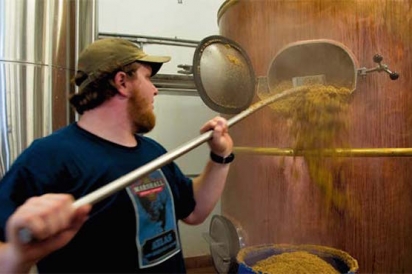Marshall Brewing Serves Up Fresh, Local
Oklahoma connoisseurs of craft brewing are well familiar by now with the name Eric Marshall—or, at least, his surname, which he lends to an ever- expanding brand of beers that he and his team of able brewmasters have been concocting for the last six years right in the heart of Tulsa.
Located at 618 S. Wheeling, the Marshall Brewing Company headquarters feels more like your typical homebrewer’s airy dream lounge than the home base of a thriving commercial operation which, as of 2013, was producing upwards of 16 distinct types of beer each year.
Many in Tulsa are likely familiar with the Marshall brand from their popular McNellie’s Pub Ale—its name intended as a “thank you” to the popular McNellie’s Group founder Elliot Nelson’s flagship Public House, who helped Marshall establish valuable business contacts at the beginnings of his company. Or they may be more acquainted with the recently available, highly recommended Arrowhead Pale Ale—a citrusy, bittersweet seasonal brew that this author has come to closely associate with summertime in Tulsa after dark.
Regardless, there is no question that the Marshall brand has established a firm foothold in the popular consciousness of Green Country’s more discerning imbibers. But as summer ’round these parts fades away into a half-remembered sweaty memory, Marshall Brewing Company has relaunched its best-selling brew: the smooth, seasonal and celebratory Oktoberfest Lager.
Now, Oktoberfests are a fairly specific type of beer, known for being more malty, dark and heavy than would suit the breezy summertime poolside—but still highly drinkable.
The lager’s notes of caramel within its classically crisp and clean profile pairs well, naturally, with well-cooked pork, be it sausage, bratwurst, pork chop or a rack of ribs. It’s a drink for German food, and autumn food. According to Eric Marshall, “Oktoberfests do very well in the fall. It’s a shift from long, hot summer ending to football starting Weather’s changing. It’s not going to be so hot anymore.”
“And it starts the festival season also,” Marshall notes. “So, you’ve got Tulsa State Fair, you’ve got Oktoberfest, you’ve got all these different festivals popping up. And of course, Tulsa Oktoberfest being a big deal. We’ve fortunately been able to participate out there for the last several years—and last year we actually took over an entire tent and brewed some beers specifically for the festival that were just limited one-off beers that we didn’t do before.”
All the more reason to attend Tulsa Oktoberfest, as though you really needed one—who doesn’t want some bragging rights? It was delicious, but they don’t make it anymore. It was a four-day special thing, you see. Wish you could’ve had it. Maybe you should’ve gone.
But the most important detail of the brewing process to Oklahoma drinkers, particularly for such a traditional style as the Oktoberfest, is proximity.
“Lagers typically are made to be consumed fresh,” explains Marshall. “So that’s the unfortunate side of being in the middle of America.
All the great German beers, by the time they make it all the way to Oklahoma, have got some age on them, so the character is degraded a bit. And that’s one of the things that I think the commitment on our end is, because I believe in the tradition, and I believe in the fresh quality of a good lager—or a pilsner— and that’s something that we can offer here that no one else can.”
Speaking personally, I, like surely many of our readers, was unaware that there was such a ticking clock element to the taste of a lager. But if anyone would have the knowhow worth trusting on this subject, it’s Marshall. During his collegiate years, and long before he started his namesake brewery, he spent over 12 months studying the art of brewmaking overseas in Germany, and still frequently makes trips back to Deutschland to learn new tricks and remain on the leading edge of brewing prowess.
“They are sort of crisper. It’s a big deal,” he says. “They’re very delicate beers. And the freshness is a big key to the flavor in those.” Compared to ever-popular India Pale Ales, which are loaded with hop flavors and thus have a larger buffer against flavor fading over time, the lager is more of a time bomb than we’ve perhaps considered—and if you’ve never had a good one, it might be the case that you’ve simply never had a fresh one.







